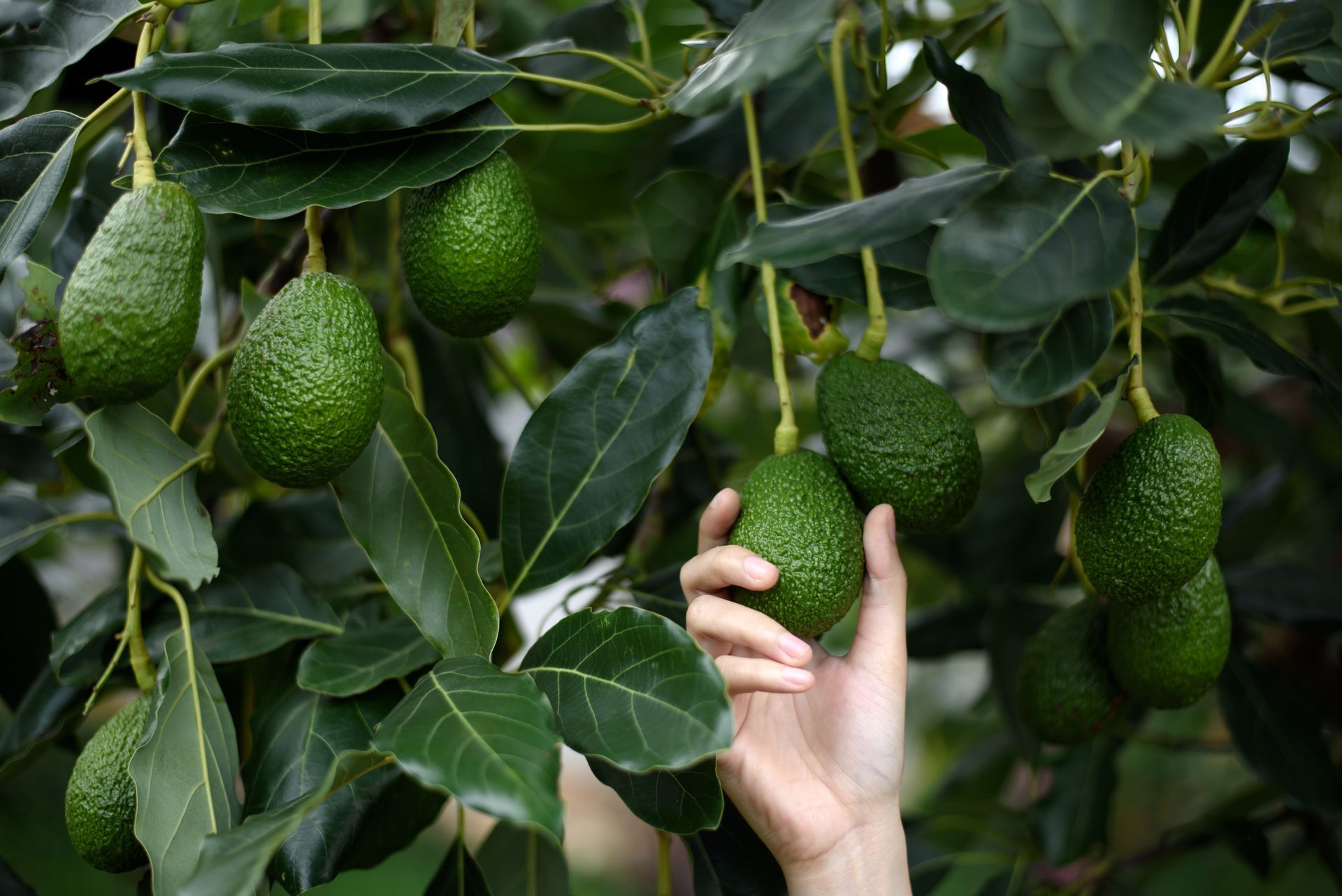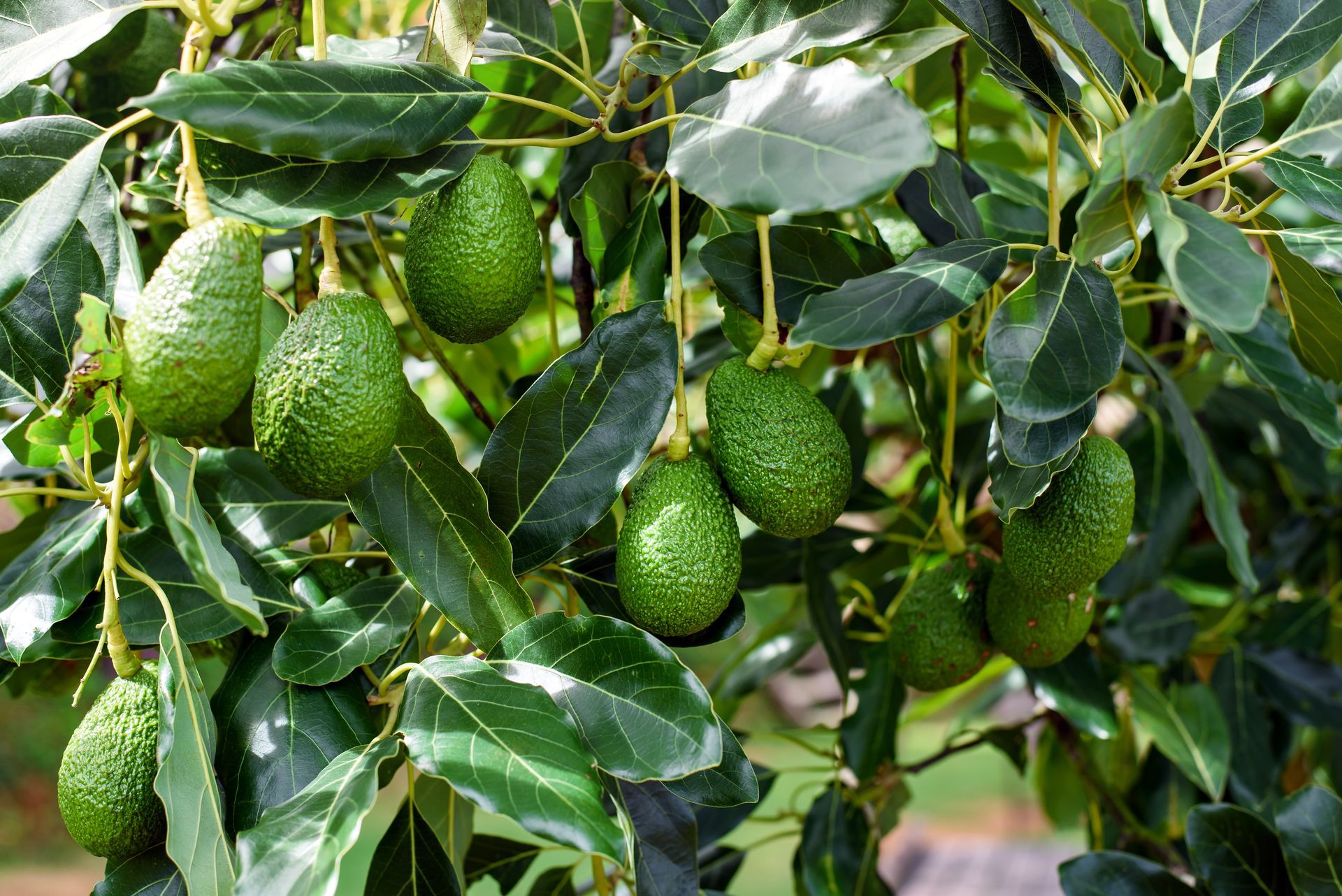Hass Avocado Tree

Hass avocado trees are self-pollinating, evergreen trees that produce fruit in after about five years. They have dense growth with leathery foliage sporting a vein-like pattern. A Hass avocado tree can grow up to seven feet when planted in a container. Meanwhile, a ground plant can grow up to 30 feet. But how do you get them to grow so tall? We covering everything you need to know below.
Fast Facts for Hass Avocado Trees
| Common Name | Hass Avocado Tree |
|---|---|
| Scientific Name | Persea americana |
| Month(s) of Harvest | April through October |
| Light | Require at least six hours of sunlight every day, but also thrive in partial shade |
| Water | Must be watered every two to three days, but watering should be skipped if the soil is already quite moist. Older trees only require watering once a week |
| Soil | Require loamy, sandy, and loose soil with a pH below 6.5 |
| Fertilizer | Only needs 1.5 to 2 pounds of nitrogen per year; fertilizer application can be divided into six to nine increments throughout the growing season |
| Pests | Susceptible to leaf roller, helopeltis, Queensland fruit fly, and red-banded thrips |
| Diseases | Prone to avocado black streak, anthracnose, fusarium dieback, branch canker, and Armillaria root rot |
| Growing Zone | Zones 8 to 11 |
Table of Contents
Credit:
Everything You Need to Know to Take Care of Hass Avocado Trees
Hass avocado trees have a lifespan of 200 to 400 years, which means they can live for generations. However, that requires providing them with the right growth conditions. Here's what you need to know about Hass avocado tree care.
Planting
The USDA hardiness zone of a plant indicates the region where the specific species thrives. Hass avocados grow well in Zones 9 to 11, which include warm climates, prevailing across Florida and southern California.
Hass avocado trees cannot bear cold winter temperatures, as they prefer full sun. Therefore, you should plant a Hass avocado tree in a southwestern region for the best growth.
When planting a Hass avocado tree, do not use the pit from an avocado you got from your local Target. Instead, get a seedling from a nursery or gardening center.
When
Plant the Hass avocado tree anywhere between March and June, as this is when the soil is relatively warmer. Choose well-draining soil in an area sheltered from strong winds.
How
Dig a hole where you want to plant your Hass avocado tree. Remove debris, weeds, and turfgrass from around this hole for up to 10 feet.
The hole should be about four times as deep as the container of the seedling and about three times its diameter in width. Do not make the hole too deep, as Hass avocado's shallow roots will not be able to pull up nutrients.
Put the seedling in the hole, keeping the root ball slightly above the surrounding soil's level. Fill the hole to cover the seedling.
Do not add any fertilizer to the plant at that moment. Water the newly planted tree every other day for the first week. After that, water it twice a week for the initial months of growth.
Care
After planting, the next step is to care for your Hass avocado plant. Here are some important things to note.

Sun and Temperature
A Hass avocado tree prefers six hours of unfiltered and direct sunlight daily. Although it doesn't mind some shade, more light exposure results in better foliage and fruit production.
As for the temperature, it should be between 60 and 80 degrees Fahrenheit. Older trees can tolerate temperatures down to 28 degrees Fahrenheit, but younger trees are not strong enough to bear so much cold.
Water and Humidity
Follow the watering routine for the first year, as mentioned above. After that, water your Hass avocado tree once a week or when the soil is not moist. You must water enough to moisten two inches of the soil's surface.
Hass avocado trees ripen well when the humidity is more than 90%. Lower humidity levels make the plant ripen quickly, but they do not result in a better fruit appearance.
Soil
Hass avocado trees prefer well-drained sandy or loamy soil. Drainage is important for a Hass avocado tree due to its shallow roots. If the soil retains too much moisture, the tree might experience root rot.
Fertilizing
Hass avocado trees do not need fertilizing when newly planted. You can fertilize your Hass avocado tree with a liquid fertilizer in its second year. Apply an ounce of fertilizer once a month from spring to fall. Smaller doses are better for Hass avocados since their roots cannot absorb too much fertilizer at once.
While most fertilizers only contain concentrated nitrogen, potassium, and phosphorus, Hass avocado trees also need supplemental nutrients. These include boron and zinc.
A Hass avocado tree with zinc deficiency has yellow leaf patches. Meanwhile, a nitrogen-deficient tree will have yellow-veined leaves. Choose a fertilizer with micronutrients to prevent these deficiencies.
Most growers recommend using a fertilizer with an NPK ratio of 6-3-3 or 2-1-1. Make sure the fertilizer is slow-releasing and organic.
Pruning
Young Hass avocado trees do not need extensive pruning. You should simply let the tree develop its shape naturally. However, prune the suckers growing below the bud union or the graft.
Although they do not need pruning, young plants need early training. Pinch the terminal shoots when the second growing season begins. Keep doing this until the tree is fully developed for lateral growth promotion.
If some Hass avocado varieties are not trained, they grow quite high. Their fruit develops in the top two-thirds of the plant, leading to a difficult harvest. If you want to maintain the tree's shape or confine it a little, you can do minor pruning.
When To Prune
Prune the Hass avocado tree after fruit setting or before bloom. Pruning at this time allows the tree to adjust the fruit load naturally in the June drop.
Do not prune a Hass avocado tree in the late season, as it leads to tender growth, which is susceptible to frost damage. When pruning, do it sparingly. Do not remove too much green wood and leaves.
Propagation
The following ways can be used to propagate Hass avocado trees:
- Layering
- Grafting
- Cuttings
- Planting seeds
Commercial growers often use grafted seedlings since they offer accelerated and uniform growth. These trees also have higher yields.
If you plan to use the seeds from your tree's fruit for next year's planting, do the following:
- Get the seed from a ripe, healthy fruit still attached to the tree.
- Treat the seed in a water bath for half an hour at 122 degrees Fahrenheit.
- Let the seed cool and dry.
- Remove the seed coat.
- Put the seed in a potting mix of two parts lite and three parts peat moss. Make sure the apical end of the seed points toward the soil's surface.
If the conditions are right, the seed will germinate in 4 weeks. The best seedling varieties you can use to grow Hass avocado trees are Topa-Topa and Mexicola.
Did You Know? Many Hass trees bloom two times a year, while some bloom thrice. A single tree can produce more than a million blooms.
Harvesting and Storing
The good thing about Hass avocados is that they do not ripen until you pluck them off. So, you can let them hang on the tree for quite some time.
Harvesting
Hass avocado trees take about five years to bear fruit. When the trees start producing fruit, you can pluck it off the tree whenever you need it.
You can follow one or both of these techniques for harvesting avocados:
- Snap Picking: It involves plucking the fruit right off the tree.
- Snip Picking: You cut the fruit from the tree using special secateurs. These secateurs are ideal for trees whose branches are high or difficult to reach.
Storing
Once you harvest the Hass avocados, keep them at room temperature. They will become soft in one to three weeks. The skin of the fruit will turn a dark purple or black color. After the fruit softens, you can store it in the refrigerator for some days.
Common Issues With Hass Avocado Trees
Hass avocados face a wide range of issues, including temperature variations, pests, and diseases. They may also suffer from root-rot fungal infections. Be attentive to spot the signs of these problems and take appropriate measures to prevent them.
Growing Problems
Hass avocados need a sunny location. Since they do not get this in a cooler climate, they may experience a couple of problems in growth. Some of them include:
- Poor carbohydrate production
- Competition between flower and shoot growth
- Insufficient number of flowers
- Poor pollination
A regular avocado needs the right temperature for pollen germination and embryo growth. If the temperature in your region is lower than what is preferred by the Hass avocado tree, it will slow down fertilization and ovule growth.
It's not too concerning, though. Fertilization still occurs, although a bit late. Too much rain, however, can be problematic, as it results in root rot.
Pests
It's important to note that there are different management strategies for each type of avocado pest. But neem oil can help against many pests, including mealybugs and avocado thrips. You can find neem oil sprays available in most garden stores.
Borers
The two main types of borers that affect Hass avocado trees are Kuroshio Shothole and Polyphagous Shothole. These are beetle-like insects that burrow in Hass avocado trees, creating tunnels for other insects to infest the plant. They also lay eggs in the tree trunk, weakening it over time.
It's very hard to spot borers as they do not stay on the tree for a long time. You'll only notice the holes in the branches and the trunk.
Since borers affect stressed Hass avocado trees, you should keep your tree healthy and well-nourished to prevent infestations. If an infestation has occurred, trim the affected branches.
Caterpillars
Caterpillars also affect Hass avocado trees. They feed on the leaves and can cause significant damage to the foliage of the plant.
Some caterpillars, such as Western avocado leafrollers, wrap around the curled leaves. Remove the affected leaves manually and cut off the branches that caterpillars have damaged.
If the caterpillar infestation is too severe, spray your tree with Bacillus thuringiensis. It is a bacterium that is found in the soil, and it is very effective against caterpillars.
Avocado Brown Mite
Spider and predatory mites are eight-legged pests with a 0.01-inch long body. They produce amber-colored eggs with short projecting stalks.
These pests affect the plant by:
- Defoliating Hass avocado trees partially
- Bronzing the leaves
- Decreasing the number of pollen-producing male flowers
- Making the fruits unmarketable
Organic control of this pest includes spraying the plants with pesticidal oils and sulfur.
Avocado Thrips
Avocado thrips affect the fruit of Hass avocado trees. These tiny, black insects feed on the fruit and leave small scars on it. The following types of thrips might affect avocado plants:
- Citrus Thrips: These are orange-yellow or white with no abdominal bands.
- Western Flower Thrips: They have abdominal bands and mostly affect flowers. These thrips also have bristle-like hairs on their abdomens.
A thrip infestation usually begins in early summer or late spring. The pests affect young fruit. However, the good news is that thrips do not directly affect the tree's health since they only cause scarring on the fruit. Severe scarring can make the fruit less marketable. In some cases, scarring can also result in stunted fruit growth.
Omnivorous Looper
The omnivorous looper is a yellowish-tan caterpillar with alternating dark and light stripes along its body. These pests feed on the avocado tree's foliage and fruit, resulting in leaf damage and fruit scarring.
Young larvae of the avocado looper feed on the surface of the leaves. Meanwhile, older insects chew through the leaf, sometimes only leaving the large veins and midrib behind. A fully-grown omnivorous looper larva can eat a whole leaf in one day.
Management involves conserving natural predators of the avocado looper, such as spiders, damsel bugs, lacewings, and assassin bugs. Also, do not apply broad-spectrum insecticide on your tree since malathion spray often results in looper outbreaks.
Diseases
Hass avocado trees are also prone to certain diseases. Here are a few of them.
Armillaria Root Rot
Armillaria root rot is a common concern for many trees and not only the Hass avocado. The disease causes the tree's leaves to turn yellow. These leaves eventually fall off the tree. Trees with Armillaria root rot produce fewer fruits.
Since the disease spreads quickly and there's no cure, it's best to prevent it in the first place. Some prevention tips include:
- Mulching the area around Hass avocado trees
- Deep watering the tree as required
- Putting up a barrier or fence around the tree to keep it safe from weed eaters
The disease can spread from one tree to its neighboring plants. Remove the tree with Armillaria root rot to keep nearby vegetation safe.
Algal Leaf Spot
Caused by Cephaleuros virescens, algal leaf spot has the following symptoms:
- Red-orange spots on both surfaces of the leaves
- Patches on the leaves
- Spots on branches and twigs
- Necrotic crust under the spot
The right way to manage algal leaf spot is to cut the weeds around your Hass avocado tree. Fertilize the tree in a timely manner, and do not plant any other tree near it for wider spacing. Apply a copper fungicide if the infestation gets too severe.
Sunblotch
Sunblotch is another disease of the Hass avocado tree that leaves white, pink, red, or yellow streaks on young steams. When the trees produce fruit, they have red or yellow blotches on them.
You can prevent this by only planting certified nursery stock. Also, sanitize your shears and other equipment when pruning avocado trees to prevent the transfer of pathogens from one tree to another.
Anthracnose
Glomerella cingulata causes the anthracnose of Hass avocado trees. The fungal disease has the following symptoms:
- Brown lesions on new shoots
- Dead leaf tip
- Necrotic spots
- Chlorotic leaves
If you notice anthracnose fungal bodies on the affected plant parts, prune the affected branches. Dispose of these branches properly to prevent fungal spread to other areas.
You can also contact your local agricultural agency for advice on using fungicides and other control measures. Store the harvested avocado fruit in a cool and dry place.
Avocado Black Streak
Avocado black streak causes canker growth on the branches and black blotches on the tree's wood. The cankers result in cracks from which sap oozes out. If you remove the bark from the cankers, you will see a dark discoloration on the wood.
The key to managing avocado black streak is to follow good irrigation and fertilization practices. Do not overwater a mature avocado tree. Also, use a nitrogen-rich fertilizer for your Hass avocado trees.
Credit:
Sweet New Earth's Final Word On Hass Avocado Trees
Hass Avocado Trees are an often overlooked tree with all the great citrus trees on the market. If you love to grow trees and are looking for something to harvest other than apples or mandarins from mandarin trees, then we definitely think you should give the Hass Avocado tree a shot.
FAQs

Christina Hernandez
Christina has done most of her research on environmental science but recently has changed her focus towards sustainable forestry. She has a passion for the outdoors and wants to spread that passion to the world.
Join our community!
Join to receive guides, insights, and the latest gardening deals!
